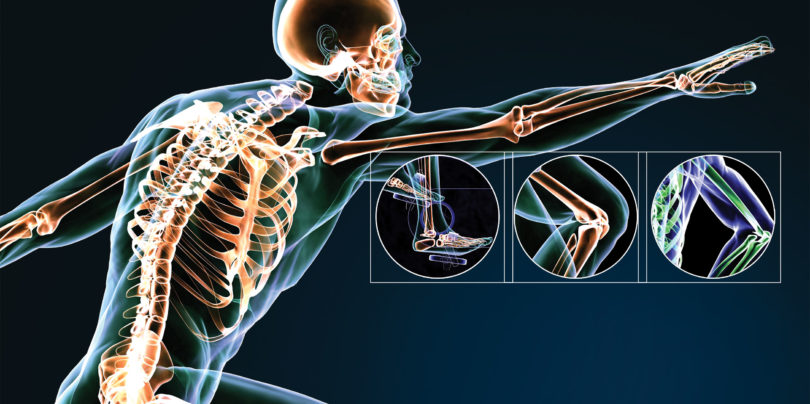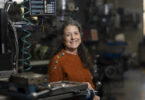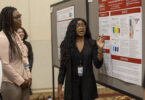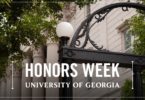Luke Mortensen’s mission is to find a way to replace missing bones in children and save lives.
Mortensen finished a postdoctoral fellowship at Harvard Medical School in fall 2014 and joined UGA’s Regenerative Bioscience Center (RBC), which links researchers and resources in various disciplines to develop cures for human and animal diseases.
The center, established a decade ago by Steven Stice, offered Mortensen access to regenerative medicine and stem cell experts and a supportive, collaborative environment. A unit of the Office of the Vice President for Research, the center has grown to include more than 30 faculty from several UGA colleges and joint efforts with the Georgia Institute of Technology, Emory University and other research universities.
On the third floor of the RBC, located on East Campus, Mortensen built a novel laser microscope, the first major component of his new lab. He wanted to use his experience in microscopes and stem cells and interest in bone regeneration in a meaningful way-specifically, to find a treatment for hypophosphatasia (HPP), a rare congenital bone disease in which bones don’t mineralize or grow properly. The condition can cause stillbirth; for those who survive, bones are softer and more likely to fracture.
“I wanted to do something where I could use those key elements that I’d gathered as I went along, and try to apply it to something where it could impact people,” says Mortensen, an assistant professor with a joint appointment in the College of Agricultural and Environmental Sciences (CAES) and the College of Engineering.
His research could result in using stem cell therapy to permanently heal individuals with HPP. Earlier this year, he began using his two photon laser microscopes to visualize living cells inside of the bone and to track the cells within the bone marrow of mice.
“We’re starting from the ground up. That was really exciting. You could see the cells zipping around,” Mortensen says. “Getting to this point was sort of an adventure.”
The ultimate goal is to replace the damaged stem cells of someone who has a genetic defect with ones that are healthy and can permanently heal them, he says.
Bone regeneration, traumatic brain injury, and the first and only stroke model using swine in the U.S. are just some of the research areas at the RBC. Faculty members include biochemists, veterinarians, pharmacologists, toxicologists and animal scientists representing the CAES, the College of Education, the College of Engineering, the College of Public Health, the College of Pharmacy, the College of Veterinary Medicine and the Franklin College of Arts and Sciences.
RBC members also have received federal research grants and funding from government, public and private entities including the National Institutes of Health, the Bill and Melinda Gates Foundation, the American Heart Association, the Environmental Protection Agency and the Department of Defense. Nearly $7.6 million in grants were awarded to RBC members in 2014-15.
UGA’s expertise in fields such as regenerative medicine and veterinary medicine, combined with partnerships with Emory and Georgia Tech, gives the RBC a strong presence at industry and international meetings. The RBC provides training and education to researchers from around the world, and research findings and papers have appeared in more than 1,000 journals and publications. In RBC’s first 10 years, it has licensed technology and products, and Stice expects that commercialization efforts will grow.
No cold calling
Friendly and warm aren’t typically words used to describe laboratories, but they frequently come up in conversations with RBC members. The RBC was created in 2005 to lay a foundation to share resources, offer training and foster collaborative research across disciplines and institutions.
In 2008, the RBC was refocused on regenerative medicine and stem cell therapy, which was becoming a more recognized area of study internationally. Stem cells are “blank” cells that can develop into any type of cell. They can be manipulated into becoming specialized cells to treat specific conditions — heart muscle cells, for example, that can be injected into a person with heart disease. RBC researchers work primarily with adult stem cells, which come from a variety of sources such as skin, teeth and muscle as well as induced pluripotent stem cells that have been genetically reprogrammed.
Since refocusing on regenerative medicine, the RBC has grown and now includes 34 faculty members, 19 postdoctoral research assistants, more than 40 graduate students, and approximately 75 undergraduate students.
“What we’ve been able to do over the years is bring in faculty from a number of different colleges, including the vet school, where a lot of regenerative medicine is being done today,” says Stice, a D.W. Brooks Distinguished Professor in CAES and Georgia Research Alliance Eminent Scholar endowed chair.
RBC has recruited top researchers and offers the opportunity for new UGA faculty to become involved. Emerging efforts include a project involving cell manufacturing with GRA Eminent Scholar Art Edison and the new Marcus Center for Therapeutic Cell Characterization and Manufacturing at Georgia Tech.
“What it’s taken to grow is really the opportunity to be able to recruit faculty directly to the center. Some of the most productive research going on at the university is going on in our better-organized centers and institutes,” says David Lee, UGA’s vice president for research.
Three years ago, UGA, Georgia Tech and Emory formed Regenerative Engineering and Medicine, a research center that seeks to establish the state as a national leader in regenerative clinical therapies. The collaboration also awards seed grants to fund work among the institutions.
“We’ve been able to bring different groups, different schools and different disciplines together and obtain funding,” Stice says. “The progress toward therapies is never as fast as I’d like it to be, although we’ve made progress and we’ve contributed to that area.”
The RBC’s interdisciplinary approach brings together faculty and researchers who might not otherwise connect, even if their offices are on the same side of campus. The RBC facilitates introductions that otherwise might feel like a cold call, says Franklin West, RBC member and CAES assistant professor. For example, he and Susan Fagan, Albert W. Jowdy Professor and associate department head of clinical and administrative pharmacy in the College of Pharmacy, attended the American Heart Association’s International Stroke Conference.
“The fact that these researchers are world-renowned experts means they’re in high demand. By having this group, we’re able to get the attention from an elite circle,” says West, whose research focuses on stroke and traumatic brain injury.
New ideas and a broader, fresh perspective can emerge from those collegial meetings and RBC events, says Maria M. Viveiros, assistant professor in the College of Veterinary Medicine. Viveiros and associate professor Rabindranath De La Fuente are studying reproductive health and how chromosomes behave and break, which can lead to genetic disorders such as Down syndrome. Their research could lead to noninvasive strategies in early prenatal care and maternal health.
When they learned about a super-resolution microscope custom-made by researchers with the College of Engineering (who were located next door), the RBC provided a natural way to connect and develop pilot experiments to look at DNA sequences in a 3D structure. The level of resolution was not possible five years ago and is a major breakthrough, De La Fuente says.
“We can break new ground in these areas and come up with completely new information,” he says. “That has been a really important example of how the RBC has been a good center that has actually integrated all these different researchers and facilitated these kinds of interactions.”
“It’s valuable access to a lot of people who are doing some very interesting things, and all of a sudden you find yourself across the table from them,” Viveiros says. “It just fosters these very easy conversations.”
Collaborating with curious students
The RBC Fellows program has grown to 78 undergraduate students, up from 50 in the 2014-15 academic year. Students can immerse themselves in research and lab work at the RBC, where they hone critical thinking, present at scientific summits off campus and publish their work.
The RBC has helped produce Goldwater Scholarship winners, as well as Gates and Udall winners, and several Goldwater, Truman, Gates and Udall nominees. In 2016, three nominees for prestigious scholarships-two Goldwater nominees and one Truman nominee-were RBC fellows.
“I don’t think I would’ve been selected as a nominee or even had a chance to apply, if I had not had my experience at the RBC,” says Hannah Mason. The UGA junior, who’s pursuing bachelor’s degrees in molecular biology and Spanish, was nominated for a 2016 Goldwater Scholarship and received an honorable mention.
Through their RBC connections and work, students spend their summers working with researchers at other institutions, such as the Massachusetts Institute of Technology (MIT) and Duke University.
“There’s no doubt in my mind that had I not had this research experience, and especially the research experience last summer (at MIT), I would not have even been considered,” says Cali Callaway, a junior pursuing a dual BS/MS in biology and artificial intelligence, who received a 2016 Goldwater Scholarship. “It really does require that you’ve done research, and done it in a substantial way, which is exactly what I’ve had the opportunity to do here.”
About 50 graduate students work at the RBC, a number Stice would like to double in the next three years.
What’s next?
The center will continue to build partnerships with industry and foundations, work strategically with other entities, including research universities outside of the state, and move innovations to the marketplace, Lee says. One RBC start-up, Cytogenesis, acquired by Viacyte, is now in clinical trials for diabetes. Stice has founded four biotechnology companies at UGA. One of those, ArunA Biomedical, provides cells to groups involved in cell therapy, particularly in the area of stroke, and it was the first company to commercialize a product that helped lead to approval of new cognitive-enhancing drugs.
Larger pharmaceutical companies are expressing great interest in this area and are starting to provide the resources to start large cell manufacturing for cell therapy, Stice says. Developing immunotherapies that use an individual’s stem cells to attack cancer in their body is one way the RBC can play a large role in commercialization.
“There are strong opportunities for Georgia to carve out a niche in stem cell medical manufacturing and transportation,” Stice says.
Another burgeoning area that stands to set the RBC apart is the development of new animal models for studies of human diseases, according to Lee. The swine stroke model was developed by a team that includes West plus RBC and vet med faculty members Simon Platt, a neurosurgeon and professor focusing on canine stroke and brain tumors; Shannon Holmes, assistant professor of advanced imaging; and Elizabeth “Buffy” Howerth, a professor of cellular and molecular pathology of disease.
“The RBC is critical to the effort. It helped me get into contact with other individuals who are like-minded and had interest in doing the stroke model,” says West. “It’s not that it would take longer. In some cases, it wouldn’t happen at all.”
— Lori Johnston (This article originally appeared in the June 2016 issue of Georgia Magazine)






